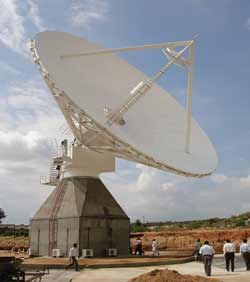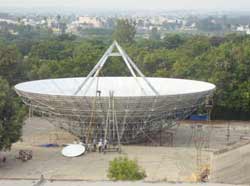Indian Deep Space Network tracks the Koguya and Rosseta space missions
14 Oct 2008
Bangalore: As preparation for its own lunar mission, Chandrayaan-I, the Indian Space Reserach Organisation's communications infrastructure, the Indian Deep Space Network (IDSN), set up to transmit and receive signals from Chandrayaan 1, successfully tracked the Japanese lunar mission Selene (Koguya) last week. Launched in 2007 this satellite is currently in orbit around the moon.
 |
| 18 m diameter antenna set up for Chandrayaan-1 at IDSN |
This operation has provided the IDSN setup ample confidence that it will be able to track the Chandrayaan-I with ease.
In addition, starting this week, the IDSN'S 32-metre antenna at Byalalu will be put into calibration and test mode with another deep space probe of the European Space Agency (ESA) called Rosetta.
This probe, launched in 2004, aims to land on the Comet 67P/Churyumov-Gerasimenko in 2014. Establishing a link with Rosetta would establish the IDSN's capabilities as a deep space tracking system.
The IDSN
Space missions that travel beyond a distance of 100,000 km from the earth are usually termed deep space missions. For ISRO, a deep space mission such as Chandrayaan will be in a different league altogether from the kind of space missions it has handled so far. Apart from development of launch vehicles these have included Low Earth Orbit (LEO) remote sensing (Indian Remote Sensing) system of satellites and geostationary communication INSAT satellites.
The IDSN set up at Byalalu, a village 40 km from Bangalore, will provide constant communication link to Chandrayaan-I from the ground. It will be used for tracking, orbit control and housekeeping operations of India's lunar mission for its entire duration of two years.
 |
| 32 m diameter antenna in its final stages of fabrication for IDSN |
The IDSN will begin to track Chandrayaan 17 minutes after its launch from the Satish Dhawan Space Launch Centre at Sriharikota, when the satellite would have separated from the launch vehicle.
Apart from the Koguya and the Rosseta the IDSN is also tracking radio stars, such as Cygnus, Cassiopeia (supernova remnant stars) as well as the sun and the moon which are all radio sources. ISTRAC sources said all these operations had already provided them with ample experience and they now knew how to maximise their signals.













.jpg)






.jpg)









